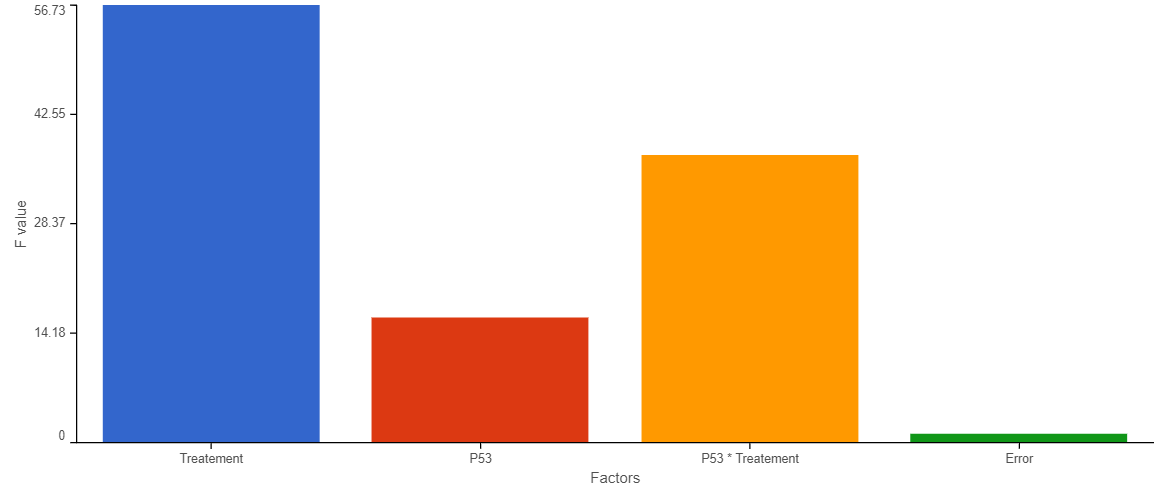Page History
Interaction plot is a statistical chart, typically used to visualize interaction effect of two factors on e.g gene expression level.
In Partek® Flow®, interaction plot is only available on result of ANOVA with two way interaction included in the model through a Feature list node, by selecting the interaction plot icon ( ) in the View column. The plot will be displayed in a new browser tab (an example plot is on Figure 1).
The Sources of variation plot presents the relative contribution of each factor included in the ANOVA model towards explaining the variability of the data for a feature analyzed by the ANOVA.
ANOVA partitions the variation for a feature among all the observations into different components. One component is the variation among the different groups of the factors in the model, which represents signal; another component is the variation within groups, which represents noise. The variance within groups is also called error, because it is the variability that is not explained by any factors. F-statistic is a ratio of the two components, that is signal vs noise ratio
F = Between group variance / within group variance
A large F value for a factor indicates that between group variation is greater than within group variation, which results in a small p-value for that factor. Conversely, a small F value for a factor indicates the between group variation is smaller than within group variation, which results in a big p-value for that factor.
In Partek Flow, the Sources of variation plot uses a bar chart to show the F value for each factor in the ANOVA model relative to the error. The plot is available for each gene in an ANOVA result. To open the Sources of variation plot for a gene in the ANOVA results table, click on the icon next to the gene symbol to invoke the plot. It is useful to examine the plot to understand the contribution of all the factors in the ANOVA model to the overall variance in the data set relative to their within group variation (Figure 1).
| Numbered figure captions | ||||
|---|---|---|---|---|
| ||||
|
The chart title is based on the feature ID (e.g. gene or transcript) that the plot was invoked on. The yY-axis is scaled automatically, based on the range of the data, and the units correspond to the input units of the parent Feature list nodethe F value, X-axis categories are the factors specified in ANOVA model and the Error term. The Error term will always have an F value of 1 because error, i.e. if the data were normalized using transcripts per million (TPM), the y-axis will be in TPM-normalised counts. Dots represent samples. Hovering the cursor over a sample invokes a popup balloon message shows sample ID and the respective expression value. The legend is in the upper right corner and is based on the data attribute specified under the Color by option (on the left)., within group variance, is the denominator in the F value calculation.
Plot controls are in the panel on the left. The <Previous and Next> buttons enable you to switch between genomic features as they appear in the parent Feature list. The Group by option defines the grouping on the x-axis, with the drop-down list containing the data attributes as present in the Data tab. As previously mentioned, the dot ANOVA results table. The bar chart colors are controlled by the Color by option Customize colors option. If you want to change a color, select customize the Customize colors hyperlink. The resulting dialog (Figure 2) will enable you to replace an existing color by a color of your choice (click on the arrow head to invoke the color mixer) or add more colors (Add color).
| Numbered figure captions | ||||
|---|---|---|---|---|
| ||||
The Connect by option is particularly useful for dependent study designs, where you can highlight the samples based on the same biological source by the connecting lines. The example on Figure 3 depicts results of a study where each RNA sample was processed by both RNA-seq and gene array; the lines connect the same samples. Finally, the Show box plot turns on (or off) per-group box-and-whiskers (for each level of the Group by attribute).
| Numbered figure captions | ||||
|---|---|---|---|---|
| ||||
Once you are pleased with the appearance of the dot plot, push Save image button to save it to the local machine. The resulting dialog (Figure 4) controls the resolution of the image file. The image will be saved in svg format, and the default file name is Dot plot.svg
| Numbered figure captions | ||||
|---|---|---|---|---|
| ||||
Use the Group order section of the control panel to change the order of the groups on the x-axis. Simply drag and drop a group label to a new position.
| Additional assistance |
|---|
|
| Additional assistance |
|---|
| Rate Macro | ||
|---|---|---|
|






